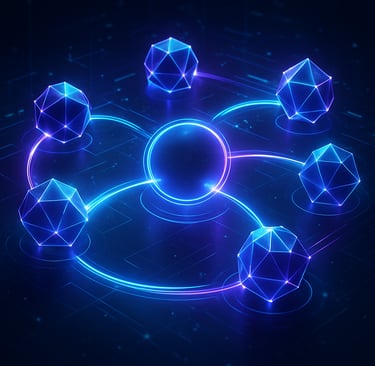A2A Protocol Enables Seamless AI Agent Collaboration
A2A is an open, vendor-neutral protocol enabling autonomous AI agents to communicate, coordinate, and delegate tasks securely, fostering interoperable multi-agent workflows across diverse platforms and improving enterprise automation.
AIARTIFICIAL INTELLIGENCETECHNOLOGYDIGITAL AUTOMATIONAUTOMATION
Eric Sanders
11/18/20253 min read


Why A2A Is the Missing Link for Truly Autonomous AI Collaboration
Imagine a world where AI agents don’t just perform isolated tasks but seamlessly communicate, collaborate, and coordinate their efforts—regardless of the platform or vendor behind them. This isn’t a futuristic dream anymore; it’s the promise of A2A, the Agent-to-Agent protocol. If you think today’s AI systems talk to each other well enough, think again. A2A stands to radically shift how autonomous agents integrate, delegate, and automate workflows, fundamentally changing enterprise automation and beyond.
Breaking Down the Silos: The Case for Agent-to-Agent Communication
Most AI agents you interact with today operate in silos. Voice assistants, chatbots, recommendation engines, robotic process automation tools—they mostly run on proprietary software stacks. When teams want these agents to work together, they often resort to clunky middleware or fragile APIs that don’t scale well across diverse systems.
A2A offers a radical alternative: an open, vendor-neutral protocol that enables autonomous agents to talk, negotiate, delegate, and collaborate securely and directly.
To grasp the impact of this, consider how different AI agents are like specialists in a gigantic organization. Each brings unique skills and knowledge but without a common language, their collaboration is inefficient or non-existent. A2A establishes that common language—allowing agents built by different developers or running on entirely different platforms to seamlessly work together in real time.
Working on AI integrations myself, I’ve often faced the frustration of trying to get disparate autonomous agents to communicate effectively. Whether in complex enterprise environments or simple proof-of-concept projects, integrating diverse AI solutions usually meant painstaking custom engineering efforts. Every environment seemed to have its own vocabulary, communication pattern, or security model.
When I first encountered the concept of A2A, it felt like discovering a Rosetta Stone for autonomous systems. The idea that agents could initiate conversations, delegate tasks, and form multi-agent workflows without human intervention signaled a significant leap forward. It’s more than just technology—it’s about unlocking new organizational efficiencies and redefining automation possibilities.
What Sets A2A Apart: Understanding Its Core Features
Let's unpack what makes A2A uniquely poised to transform AI collaboration:
- Open and Vendor-Neutral: Unlike proprietary protocols locked to specific platforms, A2A is designed for universality. This openness invites broad community involvement and rapid innovation.
- Secure Communications: In an age where data breaches are rampant, A2A incorporates security as a foundational principle, ensuring trust among collaborating agents.
- Task Delegation and Coordination: Autonomous agents using A2A don't just chat; they can assign tasks to one another, follow up on progress, and even escalate issues automatically.
- Interoperability Across Platforms: It breaks down technical barriers, letting agents from diverse environments create compound workflows that leverage their unique strengths.
- Extensibility and Scalability: The protocol supports growing ecosystems of agents, making it suitable for both small teams and sprawling enterprises.
A Deeper Dive: How A2A Changes Enterprise Automation
Automation today often means stitching together separate tools that automate fragments of a process. But true intelligent automation requires orchestration among specialized agents—bots, AI models, services—that can adjust dynamically as conditions evolve.
With A2A, enterprises gain:
- Dynamic Workflow Composition: Agents can negotiate roles and responsibilities on the fly, adapting workflows without manual reprogramming.
- Reduced Development Overhead: Teams no longer need to build complex middleware bridges for every new agent they introduce.
- Improved Reliability: Secure, direct communication minimizes points of failure compared to intermediated messaging systems.
- Enhanced Innovation: Openness drives a marketplace of interoperable agents, accelerating experimentation.
As one expert puts it, “A2A is fostering interoperable multi-agent workflows across diverse platforms, improving enterprise automation.” This means smarter, more flexible automation solutions that can evolve with business needs.
What You Can Take Away From This New Paradigm
If you are involved in AI development or enterprise automation, embracing the A2A standard promises concrete benefits:
- Future-proof your AI architecture: Build systems that can grow and adapt by collaborating across vendors and platforms.
- Focus on agent capabilities, not integration headaches: Spend time improving agent intelligence instead of custom glue code.
- Leverage secure and standardized communication: Protect data and maintain trust while enabling rich interaction models.
- Harness multi-agent synergy: Combine unique agent strengths for complex problem solving beyond any single AI’s capability.
Even those outside AI development can appreciate the broader implications. A2A paves the way for a more connected, efficient digital ecosystem where autonomous systems enhance human productivity rather than complicate it.
What’s Next in Our Journey Toward Autonomous Collaboration?
If AI agents can truly collaborate independent of their creators’ silos, how will that reshape our work, creativity, and problem-solving landscapes? When agents negotiate and delegate with each other as naturally as colleagues do, could we unlock the next step in human-machine synergy?
How ready are we to rethink automation—beyond scripted tasks and predefined workflows—toward systems that evolve collaboratively, learn from each other, and distribute intelligence across platforms? And who stands to gain the most from this revolution in autonomous agent communication?
These questions don’t just matter to technologists; they will shape how we design, interact with, and trust the AI-driven systems of tomorrow. A2A is not merely a protocol—it’s a foundational shift inviting us all to imagine a more interconnected future. Are you ready to step into that world?
Efficiency
Transform your workflows and reclaim your time.
Contact Us
Need A Custom Solutions? Lets connect!
eric.sanders@thedigiadvantagepro.com
772-228-1085
© 2025. All rights reserved.
